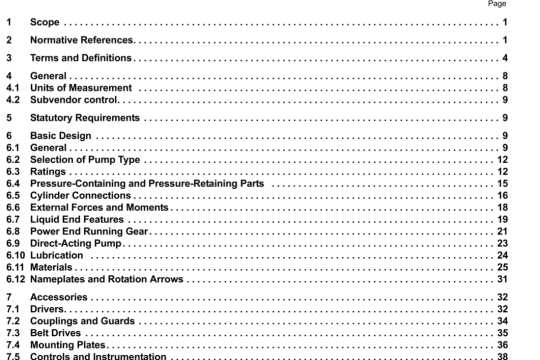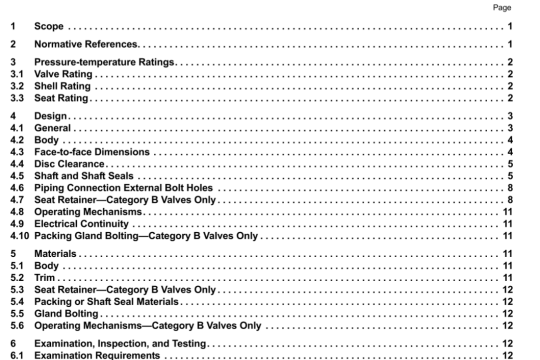API St 677:2010 pdf download
API St 677:2010 pdf download.General-Purpose Gear Units for Petroleum, Chemical and Gas Industry Services.
2.3 SHAFT ROTATION
2.3.1 The rotational direction of high-speed and low-speed shafts is either clockwise (CW) or counterclockwise (CCW), as viewed from the coupling ends of he respective shafts.
2.3.2 On the data sheets and in drawings and tables, the shaft rotational direction shall be designated by the abbreviations CW or CCW, as indicated by the circular arroWs in Figure 2.
• 2.3.3 The purchaser shall specify the rotational direction of both the high-speed and the low-speed shafts. When either or both shafts have an extension at each end, the purchaser may alternatively indicate the rotational directions on the appropriate assembly designation (see Figure 1) and submit a copy of the figure with the quotation request.
• 2.3.4 In finalizing the data for purchase, the purchaser shall prepare a sketch that shows the direction of rotation for each item in the train.
2.4 RATING
• 2.4.1 Gear-rated Power
2.4.1.1 The gear-rated power of the unit shall be specified by the purchaser. For gear units located next to the driver, the minimum gear unit rated power shall be the maximum installed power of the driver. For electric motor drivers, the gear-rated powershall be the motor nameplate rating multiplied by the motor service factor. All modes of normal and abnormal operation shall be examined. Modes of operation include the number of starts per unit of time, reduced load, removal, reversed load, reduced speed. and overload and overspeed conditions. If the maximum transmitted torque occurs at an operating speed other than the maximum continuous speed. this torque and its corresponding speed will be specified by the purchaser and shall be the basis for sizing the gear.
For gear units between two items of driven equipment. the power rating of such gears should normally be not less than items a or b below, whichever is greater.
a. 110% of the maximum power required by the equipment driven by the gear.
b. The maximum power of the driver prorated between the driven equipment, based on normal power demands.
2.4.1.2 Normal Transmitted Power
For optimal gear unit design (rotordynamics. lead modification), the purchaser should specify the normal transmitted power and any special operating conditions (such as load reversals), in addition to the gear unit rated power.
2.4.1.3 Gear unit rating shall be based on the lowest of the following capacities: tooth pitting resistance, tooth bending strength, or thermal capacity.
• 2.4.2 Gear Service Factor
The minimum gear service factor (SF) shall be specified by the purchaser on the data sheets based on the application, as listed in Table 3.
2.5.1.11 A removable, gasketed inspection cover or covers shall be provided in the gear casing to permit direct visual inspection of the full-face width of the gear elements. The inspection opening or openings shall preferably he at least one-half the width of the gear face.
2.5.1.12 Permanent coatings or paint shall not be applied to the interior of the casing unless the purchaser approves in advance the material and method of application.
2.5.1.13 On units that have pressurized oil systems with pitch line velocities above 15 rn/s (3.0(X) ft/mm), the gearbox casing shall he designed so that the gears do not dip into the oil during operation or upon shutdown. Gear units at or below 15 rn/s (3,(X)() ft/mm) pitch line velocity may dip into the oil: however, above 10 rn/sec (2,0(X) ftlmin) pitch line velocity, an oil pan shall he used to ensure rapid drainage and to minimize foaming.
2.5.2 Joints
Casing splitlines shall use a metal—to—metal joint (with a suitable joint compound) that is tightly maintained by suitable bolting. Gaskets (including string-type) shall not be used on splitlines for parallel shaft gears.
Note: Due to the interaction of the rotating elements of spiral bevel gear unis. it is normally required that the element’s mounting distances he adjustable to achieve proper tooth mesh contact and backlash. When the adjustment is made by shifting axially. in line with the element’s shaft center line of rotation by use of a combination housing cover-bearing carrier, shim type gaskets are permitted.
2.5.3 Bolting
2.5.3.1 Case bolting may be of the through-bolt. studded, or cap-screw type. Threaded bolt holes shall not penetrate through the wall into the interior of the casing. Disassembly shall not require removal of studs.
2.5.3.2 Studded connections shall be furnished with studs installed. Blind stud holes should be drilled only deep enough to allow a preferred tap depth of 1 1/2 times the major diameter of the stud: the first 11/2 threads at both ends of each stud shall be removed.
2.5.3.3 Bolting shall be furnished as follows:
a. The details of threading shall conform to ISO 261. ISO 262. ISO 724, ISO 965 (to ASME B 1.1).
b. Adequate clearance shall be provided at bolting locations to permit the use of socket or box wrenches.




